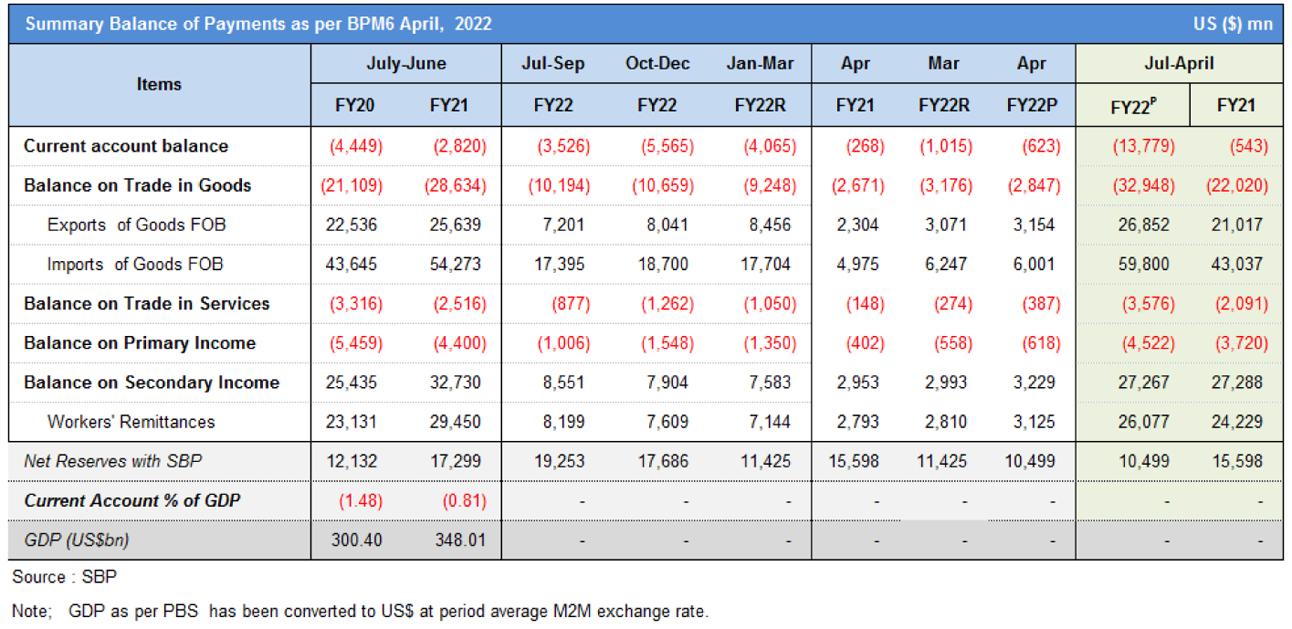The current account deficit has been tamed to $623 million in April 2022. That is a sigh of relief in the midst of an otherwise very precarious political and economic crisis the country is facing. The deficit is low in April due to exceptional performance in exports of good and home remittances which were both recorded at the highest ever levels in country’s history. Exports for the second consecutive month are over $3 billion mark while remittances crossed the $3 billion mark for the first time.
The problem on the external front is dwindling foreign exchange reserves and uncertainty about IMF and other lenders. Otherwise, the current account is slowly coming down. However, the growing international commodity prices and unchecked subsidized energy (petroleum and electricity) consumption are putting further pressure on the imports. The fiscal slippages due to subsidy would have an adverse impact on the current account in months to come. And to control that, interest rates will have to move further up, and currency has to be further depreciated. To make things better, these subsidies should be gradually waned off.

Imports stood at $6 billion in April2022. That is a new normal. And growing commodity prices would have an adverse impact. The recently announced ban on luxury imports is primarily for optics and would have minimal impact on actual imports growth. The country needs to lower the imports f petroleum to make a meaningful impact. And overall imports (broad based) must be slowed.
For this to happen, administrative measures such as four days working week, closing commercial activities by 6 PM with Saturdays and Sundays off, limiting public gatherings (weddings etc to 150 people), load shedding of 4-6 hours in residential areas, higher toll taxes on motorways for private cars and abolishing toll on buses and other similar steps to force aneconomic slowdown. Otherwise, half baked ban measures (without thinking through) could have adverse consequences.

Anyhow, the import bill stood at $6.0 billion in April 2022.Previously, there was a case of higher imports through non-banking channelswhich has now reduced to $205 million in April as compared to the average of $597 million in the first seven months of this fiscal. Thereduction started back in Feb 2022. Earlier, higher imports were due to COVID vaccines imports and some other equipment which many say were military equipment imports.
Then food imports were relatively lower in April – standing at $541 million as compared to an average of $700 million in the last nine months of this fiscal. The decline is mainly in other food items: there were no wheat imports and generally a slowdown for food group imports. Nonetheless, palm oil imports are at very high levels as compared to the numbers in the previous years – 10MFY22 palm oil imports are almost double of what it was two years ago. This is adding around $1.5-1.8 billion burden this year. This is due to price effect. Smaller and fewer public gatherings would make some dent on the palm oil imports.

Machinery imports continued to be high – up by 21 percent to $8.1 billion in 10MFY22. TERF related imports pressure has continued. Top grower is textile machineries – up by 70 percent to $1.05 billion in 10MFY22. This would have a positive impact on future exports. Mobile phone (though fell by 8 percent in 10MFY22 to $1.5 bn) is the single biggest contributor to machinery imports.
Transport imports grew by a higher quantum due to higher influx of cars and other vehicles – up by 43 percent to $3.1 billion. CBUs car imports is up by 57 percent to $286 million. The growth in buses and other heavy vehicles is higher – up by 94 percent to $169 million. Around half of transportation imports are of CKD cars – up by 58 percent to $1.5 billion. It is pertinent that these bereduced. Then aircrafts, ships and other imports remained flat.

The elephant in the room is petroleum imports. Thesealmost doubled compared to last year levels to $14.5 billion in 10MFY22. Higher prices and unabated growth (due to continued subsidies) are the reasons for higher imports. Petroleum products (mainly petrol and diesel) are up by 108 percent to $7.6 billion while the LNG imports are up by 110 percent to $2.8 billion. Then the growth has remained higher in all other items as overall imports are up by 39 percent to $59.8 billion in 10MFY22.
Goods exports are doing well. The toll is at $26.8 billion in 10MFY22 – up by 28 percent. This all set to reach $32 billion for this fiscal year. Food exports are up by 17 percent to 4.4 billion. The star performer is textile where the toll is up by 29 percent to $15.1 billion. Knitwear exports alone are to cross $400 million this year.

However, due to higher imports growth, the goods trade deficit increased by 50 percent to $33 billion in 10MFY22. That is a cause of concern. Exports services are doing well – up by 18 percent to $5.8 billion. Thanks to better performance in ICT. However, import services are growing at an evenhigher pace – up by 34 percent to $9.4 billion. That is due to higher imports and opening of travel.
Remittances havecome to the rescue. But its growth is muted relative to trade deficit. That is why the current account is slipping. With drying foreign reserves, it’s imperative to further slash current account through striking where it is needed.

























Comments
Comments are closed.